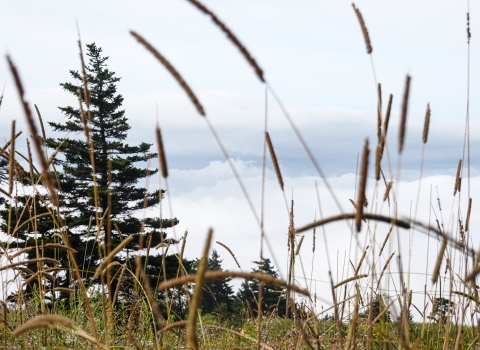I kept my disappointment to myself.
The task was straight-forward - check thirty spots within a nearly 10-acre plot for the endangered spruce-fir moss spider. This plot would be one of six checked this year, one of 36 checked over the course of the six-year investigation and part of a long-term monitoring plan to track the status of this tiny, endangered animal.
This plot was in Great Smoky Mountains National Park, near Clingmans Dome, at the very top of the park. Stepping off the ridgeline and into the plot meant going nowhere but down. Fast. From above it seemed we would descend a cliff face in search of this spider (to monitor the endangered spreading avens plant, another southern Appalachian, high-elevation species, biologists actually do rope up and descend cliff faces). These plots were chosen at random from across the spider’s range, and this random pick was some bum luck, hence my silent disappointment.
Of the handful of people in the world who stand head and shoulders above the eight billion rest of us in their knowledge of this spider, two were right here – U.S. Fish and Wildlife Service biologist Sue Cameron, the Service’s expert on the spider, and Brian Bockhahn, a N.C. State Parks education specialist who has developed a keen expertise in the spiders of North Carolina. Then there was me, the guy staring down that slope, keeping his mouth shut, knowing every step downhill probably meant three or four coming back up, plus a lot of heavy breathing. A third spider expert, Dr. Fred Coyle, professor emeritus, Western Carolina University, wasn’t here on this day, but we were following in his footsteps – he had visited this site in 2009, finding several of the endangered spiders.
Much of what we know about this spider is thanks to Dr. Coyle. It’s tiny - fitting on the top of a pencil eraser. It’s only found in the highest places of Southern Appalachia – where the cold, moist climate fosters the mats of non-vascular plants like mosses, liverworts, and hornworts where the spider spins its web. This narrow distribution means this spider contributes to the uniqueness of Southern Appalachia, making it a key part of the region’s natural heritage. Also, in the face of climate change climate change
Climate change includes both global warming driven by human-induced emissions of greenhouse gases and the resulting large-scale shifts in weather patterns. Though there have been previous periods of climatic change, since the mid-20th century humans have had an unprecedented impact on Earth's climate system and caused change on a global scale.
Learn more about climate change , the future of these cold, moist high-elevation forests is uncertain, and the spider’s plight is a bellwether of larger changes that may be afoot on the landscape.
The first task was to drop down to the center of the plot – where protocol dictated the search begin. At this elevation, the forest rarely experiences natural fire – too cool and wet. What you get is a slope covered in decades of downed logs and branches, much of which is too rotten to support a person, and covered by slick moss, some of it holding water just like a kitchen sponge. From the center we fanned out, sweeping to the bottom of the plot and climbing and crawling back up, checking thirty points that looked spidery (not an official description).
Once the trail had been broken, hair filled with debris, and pant seats soaked (for those who, like me, passed on wearing rain pants), the tally on the day was two spiders. Not stellar, but not bad - after all, this is an endangered species and each one counts.












